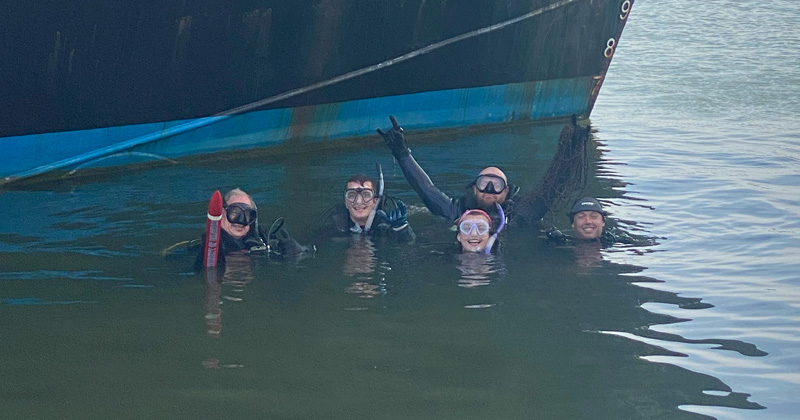


Robot wranglers
Photos courtesy of Cecily Duggan November 19, 2024
When an underwater robot went missing, UD student divers came to the rescue
Move over, Nancy Drew. The Case of the Vanishing Robot calls for Blue Hens.
At least it did earlier this fall, when an autonomous underwater vessel (AUV) lost its GPS signal and disappeared somewhere along the edge of the Delaware Bay and Atlantic Ocean.
As part of a larger fleet belonging to mechanical engineering professor Bert Tanner, the device helps conduct coordinated measurements of water salinity and temperature, data that can have major implications on our understanding of environmental health, resource management and ecosystem stability.

Students Kleio Baxevani and Chanaka Bandara were herding a swarm of robots when one veered off course. They searched for it on kayaks, but when those efforts proved unsuccessful, they called Tanner, who called Mike Birns.
As the University’s diving safety officer and scuba instructor, Birns recruited a team of five fellow divers, including undergraduates Cecily Duggan, Kelly Logan, Evan McArdle and Andrew Mulligan, and alumnus Grant Otto, operations manager for advanced underwater systems at UD.
“This is exactly the kind of mission we train for,” said Birns, who had previously taught the group during a Winter Session SCUBA training expedition in Florida. The experience included advanced underwater navigation, search and recovery training, as well as night dives.
The Delaware search would prove even more challenging — with visibility levels near zero.
“Black-water diving was completely new to me,” said Logan, “but I enjoyed putting all of my training to work.”
Prepping for the robot rescue took a week. Schedules had to be coordinated, safety protocols put in place. The captains and crews of research vessels docked in the basin had to be consulted, and the whole operation had to be timed with an inbound tide.

There was also a bit of detective work. “We had the AUV’s last-known position and trajectory,” said Birns. “We also knew that the robot would float, and if it did, it would get caught under something.”
It did. The crew hit the water around 2 p.m. and returned less than an hour later with the robot in tow. The pesky device had been trapped beneath one of the University’s research vessels.
“When I surfaced, all I could think was, ‘That was the coolest thing ever!’” said Logan. “Seeing everyone’s skills develop while diving together in Florida was incredible, but working in a real recovery was one of the best feelings. It taught me that if I can handle diving in black-water, I can handle anything.”
Birns would agree. “Every member of the team played a crucial role, and they all performed perfectly.”
And if ever another robot goes missing, researchers will know who to call.
“It’s incredible to have a group of really capable undergraduates who can help in a moment’s notice,” said Otto, who earned his mechanical engineering degree from UD in 2019 and his master’s in oceanography in 2022. “As the joke goes: ‘You’re not really a robot operator until you’ve lost one.’”
Contact Us
Have a UDaily story idea?
Contact us at ocm@udel.edu
Members of the press
Contact us at 302-831-NEWS or visit the Media Relations website

